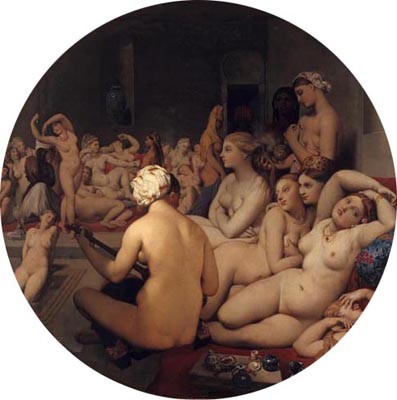The frequent appearance of female bathers and odalisques in Ingres’ paintings stemmed from the artist’s fascination with the female nude and his search for the classical ideal. This quest – one might even say obsession – reached its climax towards the end of his career with The Turkish Bath, a painting of complex provenance.
It would appear that an initial version was begun for the Comte Demidoff in 1852. Yet in December 1859, it was the Prince Napoleon who received the painting, delivered in a rectangular format. However, this was soon returned to the artist – perhaps as early as the first few weeks of 1860 – after the prince, according to Philippe de Chennevières (writing in his Souvenirs d’un directeur des Beaux-Arts), “quickly grew disgusted with it”. In truth, it was the prudish Princess Clotilde – the prince’s wife – who had been offended by this gynaecium scene with distinctly Sapphic overtones, and the painting was quickly dispatched back to the studio, where it was re-cut to take on the circular form it is found in now. In the bottom left-hand corner is the inscription “J. Ingres Pinxt. MDCCCLXII Aetatis LXXXII“, the signature a proud testament (also visible in his other paintings from the period) to the artist’s advanced age. Despite the year being indicated as 1862, we know that Ingres continued to work on it until 1863.
The Turkish Bath sees Ingres give free rein to his idealised vision of the Orient, the product of a fertile imagination inspired by his reading of Lady Montagu’s correspondence (the wife of the British ambassador to Turkey during the eighteenth-century), and in particular her detailed description of the female baths in Adrianopolis in 1716.
At first glance, the painting appears to be little more than a scene of languid debauchery permeated by a sense of overbearing voluptuousness and exaggerated sensuality – in short, an erotic reverie pushed to its very limits. A closer look however reveals The Turkish Bath to be the product of the artist’s study of the plastic arts and the combination, continuation, and rearrangement of forms and attitudes that punctuate his entire oeuvre. A key figure in the composition is the Valpinçon bather, who was first depicted in 1808 only to reappear in Harem interior, a later painting from 1826. In The Turkish Bath, the figure takes the form of a lute player, positioned in the foreground with her back to the viewer. This synthetic composition combines Ingres’ various artistic studies into a formal symphony of lines, arabesques and curves, accentuated by the canvas’ tondo format. The result is a glorification of the flesh – full, smooth, and idealised – and of the contoured form.
The Turkish Bath was only ever presented to a handful of select few invited to the artist’s workshop in 1864, but even then the scent of scandal had begun to linger about it. In 1867, Khalil Bey – the Turkish former ambassador and a well-known collector who also owned Gustave Courbet’s The Origin of the World – paid 32,000 Francs for the masterpiece. The painting was finally unveiled to the public at the Salon d’Automne of 1905, where it met with enthusiastic praise from many, including Picasso and Matisse.
Karine Huguenaud (tr. H.D.W.)
March 2012


